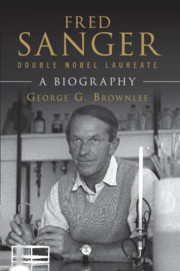Book contents
- Frontmatter
- Dedication
- Contents
- List of figures
- Foreword
- Acknowledgements and original sources
- Brief chronology
- Honours
- Introduction
- 1 A Quaker upbringing
- 2 How about studying insulin?
- 3 Radioactive sequencing of proteins and nucleic acids
- 4 Interview of Fred by the author in 1992: Early life
- 5 Interview of Fred by the author in 1992: Insulin and the Biochemistry Department, University of Cambridge
- 6 Interview of Fred by the author in 1992: Nucleic acids at the MRC Laboratory of Molecular Biology, Cambridge
- 7 Post-Sanger sequencing: high-throughput automated sequencing
- 8 Cancer: the impact of new-generation sequencing
- 9 Commentaries on Fred Sanger’s scientific legacy
- Epilogue
- Appendix: Complete bibliography of Fred Sanger
- Notes
- Index
- Plates
6 - Interview of Fred by the author in 1992: Nucleic acids at the MRC Laboratory of Molecular Biology, Cambridge
Published online by Cambridge University Press: 05 November 2014
- Frontmatter
- Dedication
- Contents
- List of figures
- Foreword
- Acknowledgements and original sources
- Brief chronology
- Honours
- Introduction
- 1 A Quaker upbringing
- 2 How about studying insulin?
- 3 Radioactive sequencing of proteins and nucleic acids
- 4 Interview of Fred by the author in 1992: Early life
- 5 Interview of Fred by the author in 1992: Insulin and the Biochemistry Department, University of Cambridge
- 6 Interview of Fred by the author in 1992: Nucleic acids at the MRC Laboratory of Molecular Biology, Cambridge
- 7 Post-Sanger sequencing: high-throughput automated sequencing
- 8 Cancer: the impact of new-generation sequencing
- 9 Commentaries on Fred Sanger’s scientific legacy
- Epilogue
- Appendix: Complete bibliography of Fred Sanger
- Notes
- Index
- Plates
Summary
Fred Sanger (FS) and I (GB) are seated in a recording studio at Imperial College, London. This is a slightly edited transcript of the final interview.
Move to the new lab
GB At this time, in 1962, you moved to a new lab in Cambridge.
FS Yes, that’s right. This was to the Laboratory of Molecular Biology (Figure 44).
There were two groups in Cambridge, really, my own group working in Biochemistry and we had nothing to do with the teaching, so we were the poor relations. We were supported by the Medical Research Council (MRC). Then there was Perutz’s group in the Cavendish – working in the hut in front of the Cavendish. Both of us were looking for possibilities of new labs and expansion – particularly them. The MRC decided to build a new lab for us – the new Laboratory of Molecular Biology which was completed in 1961.
GB You took with you your own extended group.
FSYes, the new laboratory had three groups at that time. There was the Structural Studies group headed by Perutz, who was also head of the lab. John Kendrew, Aaron Klug and Hugh Huxley were there. And there was Francis Crick’s group, called Molecular Genetics, later Cell Biology. Sydney Brenner was in that group (Figure 45). There was my group (Figure 46) on the top floor, called Protein Chemistry. No mention of nucleic acids at that time. I was joined by various people, who had worked with me in Biochemistry – Leslie Smith who had been on the insulin work (Figure 41), Ieuan Harris (Figure 46) and Brian Hartley (Figure 46). Brian had worked on the important project of sequencing chymotrypsin. He completed that in the Molecular Biology Lab.
- Type
- Chapter
- Information
- Fred Sanger - Double Nobel LaureateA Biography, pp. 98 - 135Publisher: Cambridge University PressPrint publication year: 2014



